Public art represents art in any media whose form, function and meaning are created for the general public through a public process. By integrating into community spaces like public libraries, public art is uniquely accessible. It can exist in many forms, including but not limited to:
The pieces of art at our libraries are varied. Some serve a function, express a theme, or commemorate important people and places. Some serve as landmarks. Some are integrated into a building while others are distinct works.
A
B
C
D
E
F
G
H
I
J
K
L
M
N
O
P
Q
R
S
T
U
V
W
X
Y
Z
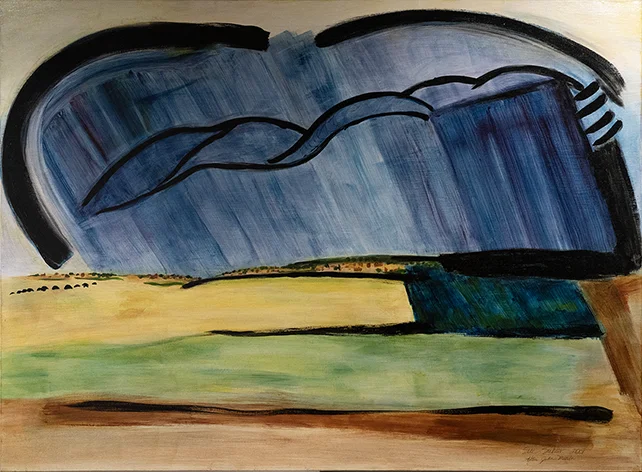
After John Marin, 2001
Location: Rockwell Branch Library
Artist: Sue Suhler
Acrylic on canvas
Donated by the artist to the Rockwell Branch Library. This work was apparently inspired by the 1930 John Marin painting Storm Over Taos.
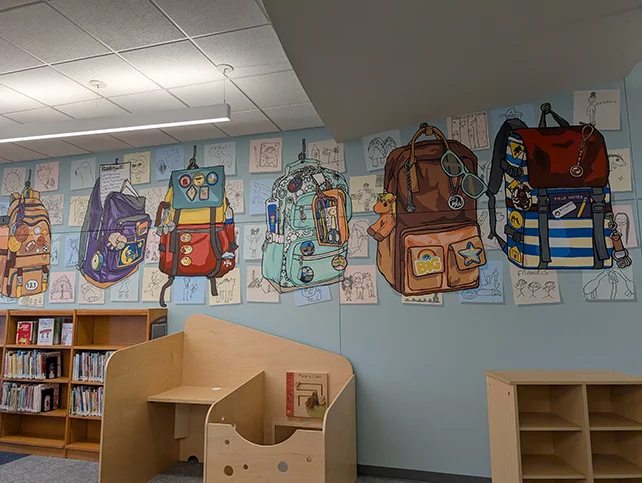
Alford children's room mural, 2025
Location: Alford Branch Library
Artist: Heather Byers
The artist surveyed 600 Wichita Public Schools students—primarily 3rd-5th graders from Kelly, Woodman, and Franklin elementary schools—about their interests and priorities. Survey responses helped determine the themes for the 12 backpacks, which include nods to Wichita institutions such as Botanica, CityArts, Cowtown, and the Wichita Aviation Museum.
"The best part of all though I think is the collection of pictures in the background! Those are images originally drawn by 91 different kids, each with their own story, some described on the pages they returned to me. I wish I could share even more than these! All of the kids who helped me in this project did such a fantastic job. I'm truly honored to have been able to collaborate with them and paint their mural." (quoted in part from the artist's Facebook page)
Alford children's room mural video
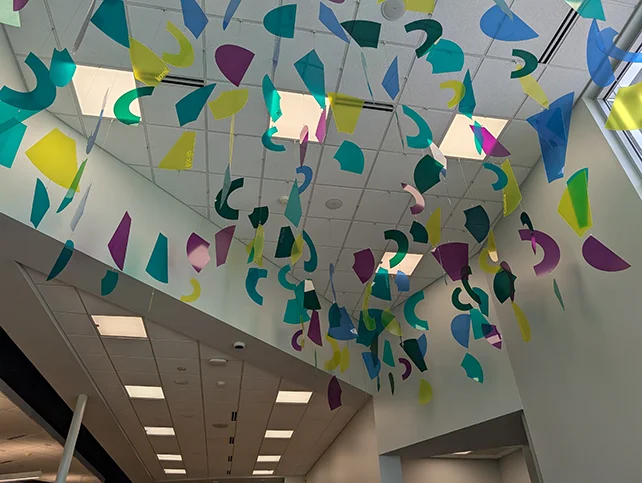
Alford teen space art, 2025
Location: Alford Branch Library
Artist: Jessica Wolf
This artwork is composed of translucent acrylic pieces in multiple colors and shapes. The shapes of the acrylic pieces were inspired by the shape of the building when viewed from above. Words printed on the acrylic pieces were chosen by members of the Library's Teen Advisory Board, translated into multiple languages.

Angelou fiber art, 2025
Location: Angelou Northeaast Branch Library
Artist: Malissa Long
This piece was the result of a community art project that included at least 105 students from Gordon Parks Academy. It is composed of around 200 fiber art collage pieces that are approximaely 3 inches by 3 inches.
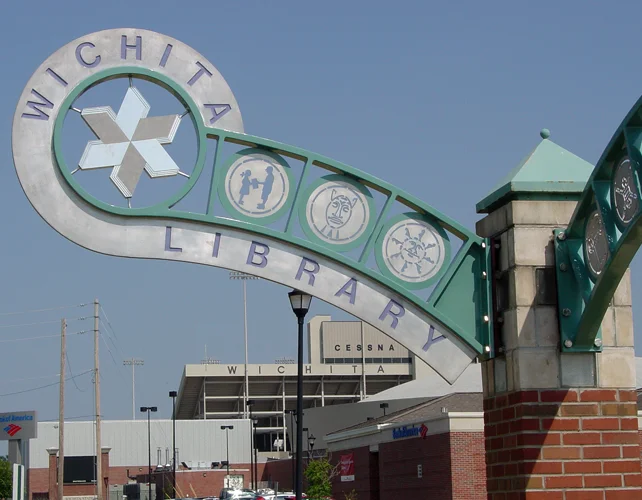
Angelou gateway, 1996
Location: Angelou Northeast Branch Library
Artist: Norm Terry
The concept of this art piece is to use symbols and designs representative of various cultures, joined together by the star from the Wichita Public Library's logo.
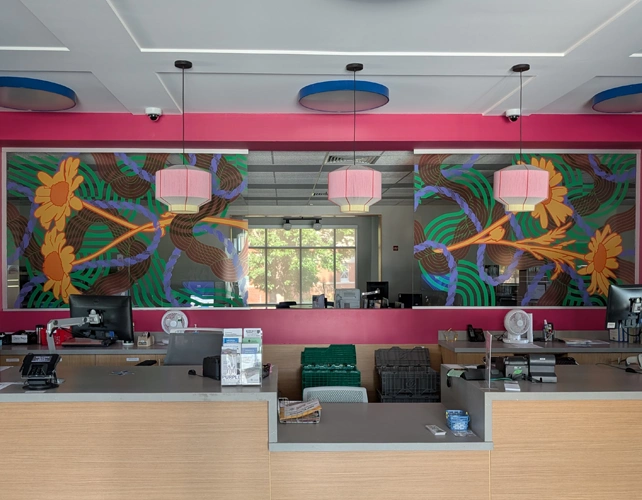
Angelou glass art, 2025
Location: Angelou Northeaast Branch Library
Artists: Armando Minjarez and GLeo
This art features Marguerite daisies, a reference to Maya Angelou's given name of Marguerite Annie Johnson. After seeing the design, City of Wichita staff approached the artists to create a version of this artwork for a bus shelter about a half mile west of the library on 21st Street near the Boys and Girls Club. The City's Design Council approved the concept design for the bus shelter in June 2025.
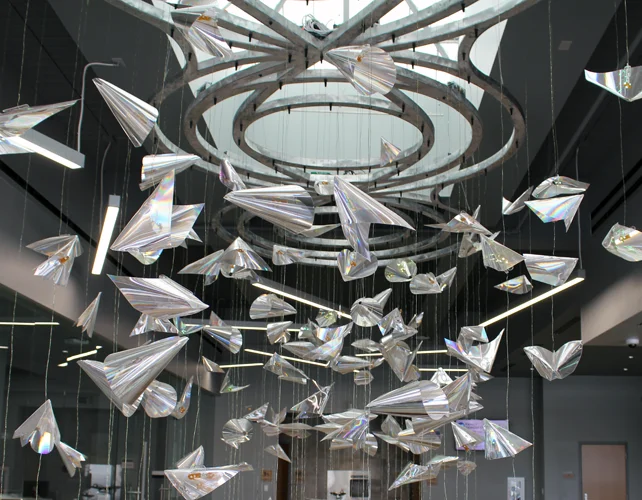
Avian Migration, 2018
Location: Advanced Learning Library
Artists: Lisa Rundstrom, John Harrison, and Tom McGuire
Consisting of an interactive network of suspended avian forms, which contrasts timeless cycles with irreversible change, it juxtaposes our technological advances with the historical cycles of Wichita's past – the land, wildlife, industry, and migrations of the Native American Peoples.
The colors and sizes represent the following avian/bird types which correspond with activity in distinct sections of the library:
- Meadowlark (Yellow & Brown) – East Entrance
- Purple Martins (Purple) – Technology / Teen
- Blue Birds (Blue) – Children's Pavilion
- Finches (Red/Yellow/Orange) – Streetscape Pavilion
- Cardinals (Red) – Upstairs Main Lobby
- Robins (Orange) – Learning Pavilion
- Hawks (Turquoise & Brown) – Research Pavilion
The migrations patterns give homage to the recorded migrations of the Native American tribes who traveled between what is now referred to as the Arkansas River and Wichita Falls. These include the Wichita People and their affiliated tribes the Waco, Keechi Tawakoni, Taovayas (Tawehash) and other tribes from the region such as the Pawnee, Osage and others.
Avian Migration images and videos
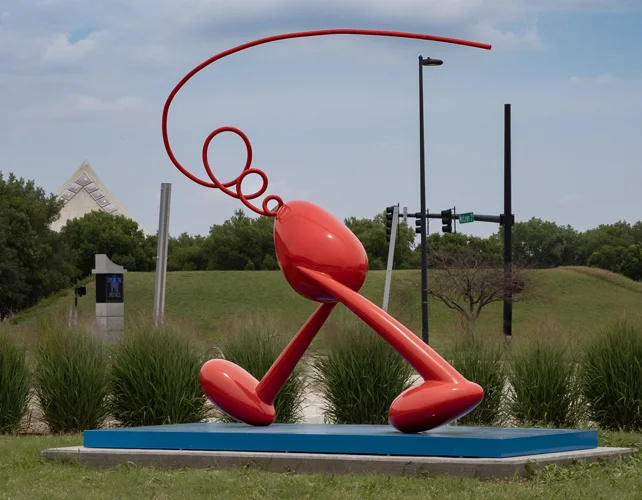
Big Red, 1985
Location: Advanced Learning Library
Artist: David Stoltz
Painted steel, 99 x 99 x 35 in. Originally commissioned for Willowbend Golf Course, Big Red was donated to the City of Wichita in the 1990s and kept in storage. In early 2020, it was proposed to restore the sculpture and place it outside the Advanced Learning Library. It was installed on June 23, 2023.
From the artist: "In the early to mid-'80s, when Big Red was made, I began looking for ways to incorporate representation into my abstractions. In the following years, Big Red would evolve into the many characters that form a carousel which I call the Circus of Life. It is finally nearing completion, as you can see on my website. I feel proud that the city of Wichita owns Big Red, a seminal work that has fueled my later career by leading to the creation of the more than 50 characters that make up Circus of Life."
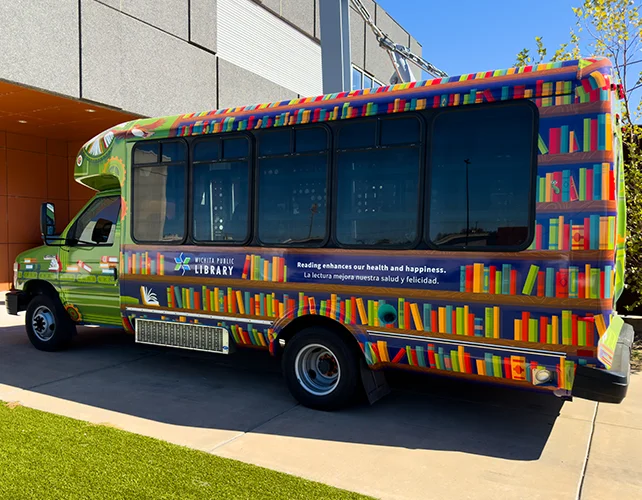
Book Bus wrap, 2023
Location: Book Bus
Artist: Lindsey Kernodle
The Wichita Public Library Book Bus, an outreach initiative to bring library services to children and familes in areas of Wichita that don't have quick access to a physical library location, officially launched on November 4, 2023. The design was unveiled on August 2, 2023.
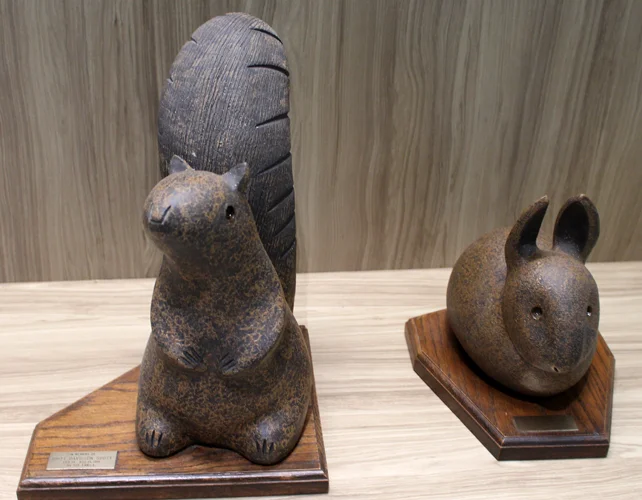
Britt Davidson Scott squirrel and rabbit sculptures, date unknown
Location: Westlink Branch Library
Artist: John Seymour (1920-2007)
John H. Seymour was a ceramic sculptor who owned and operated a studio in Connecticut. He exhibited sculptures of animals nationally. These two pieces came from a local gallery and were donated to the Westlink branch by Joe and Sandy Scott in memory of Britt Davidson Scott (2/14/1981-8/14/1981).
Britt Davidson Scott squirrel and rabbit sculpture images
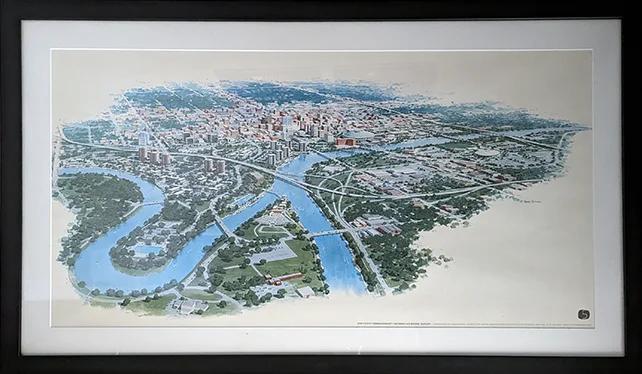
Center City Design Concept for Wichita's Second Century, 1968
Location: Advanced Learning Library
Artist: Doran Barham (1926-1999)
In the late 1960s, the firm of Oblinger-Smith prepared a study under contract with the Urban Renewal Agency of the Wichita, Kansas Metropolitan Area. The purpose of this study was "to establish general design objectives for the development of all lands within the jurisdiction of the Urban Renewal Agency affected by the Arkansas and the Little Arkansas Rivers with specific attention to the Center City Area." The study corresponded to the start of Wichita's second century as a city in 1969-70.
A smaller, colorless version of this image appeared in the Oblinger-Smith publication "The River Corridor." That publication, prepared in November 1968, called for several changes including an amphitheatre to be built at the confluence of the Arkansas and Little Arkansas Rivers, a new sports complex at the site of Lawrence Stadium, and some form of sky tram (not pictured) to transport people between the amphitheatre, the sports complex, and potentially Old Cowtown Museum.
Center City Design Concept for Wichita's Second Century images
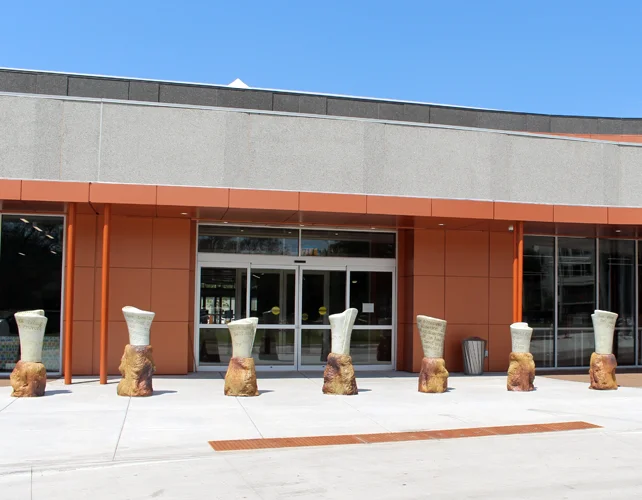
Concentricity, 2018
Location: Advanced Learning Library
Artist: Conrad Snider
These art pieces show how knowledge grows and expands over time, like the rings of a tree. The lower half of each piece represents the form and substance of a tree, while the top half shows scrolls containing quotations from writers who both entertain and cause us to think.
Concentricity images and video
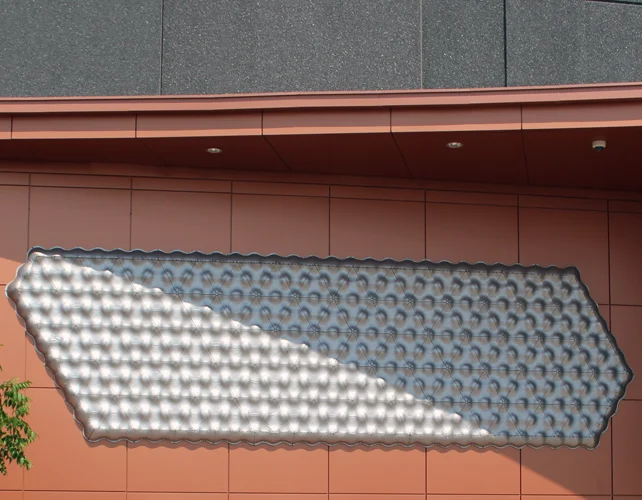
Electron Membrane 1, 2018
Location: Advanced Learning Library
Artist: Eric Schmidt
"Electron Membrane 1" is a stainless steel art piece that represents the ongoing study of efficiency, science, and art.
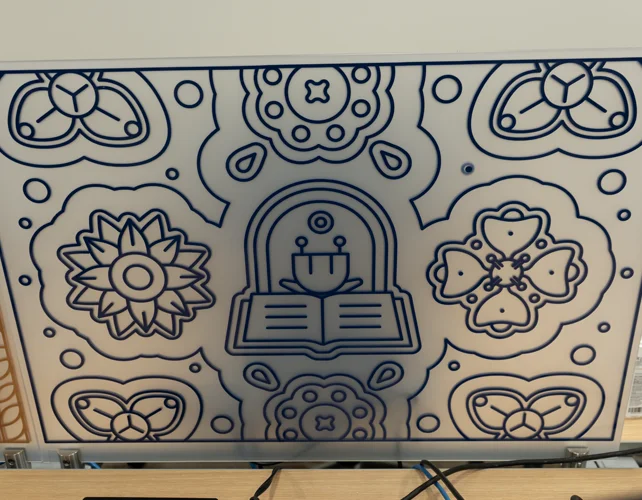
Evergreen acrylic dividers, 2022
Location: Evergreen Community Center and Library
Artist: Carlos Palomino
These acrylic dividers highlight native flowers, plants, and animals.
Evergreen acrylic dividers images
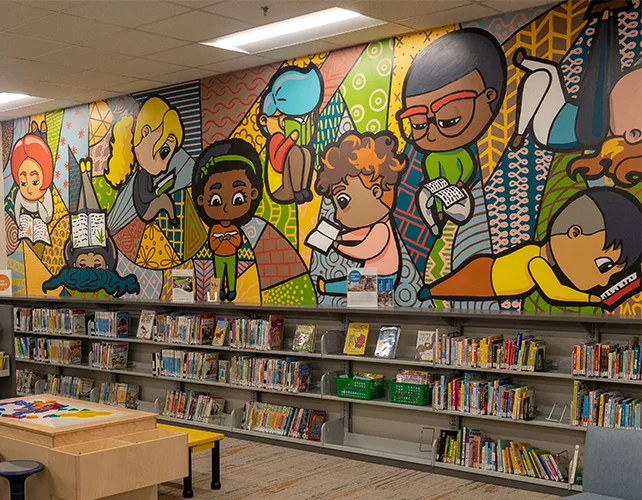
Evergreen children's area mural, 2022
Location: Evergreen Community Center & Library
Artist: Heather Byers
"February 2022. I played with a fun new style on this one, but with my favorite featues still of bright colors and bold lines." (from the artist's website, no longer available)
Evergreen children's area mural images
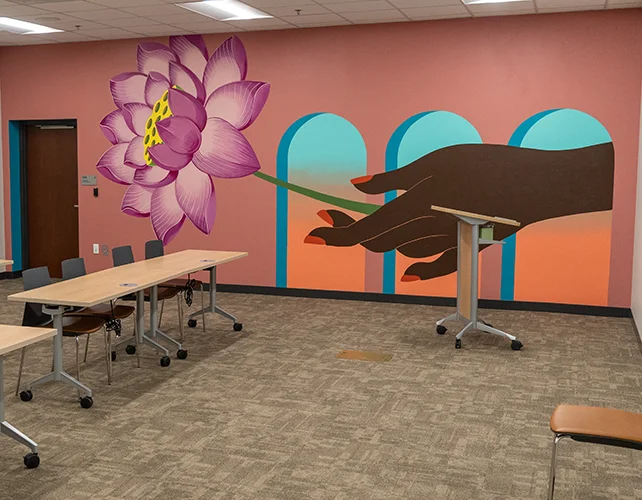
Evergreen classroom mural, 2022
Location: Evergreen Community Center & Library
Artist: Armando Minjarez
A lotus flower, an iconic representation of the Asian community. The extended hand brings an element of people with a poetic sense of calmness.
Evergreen classroom mural images
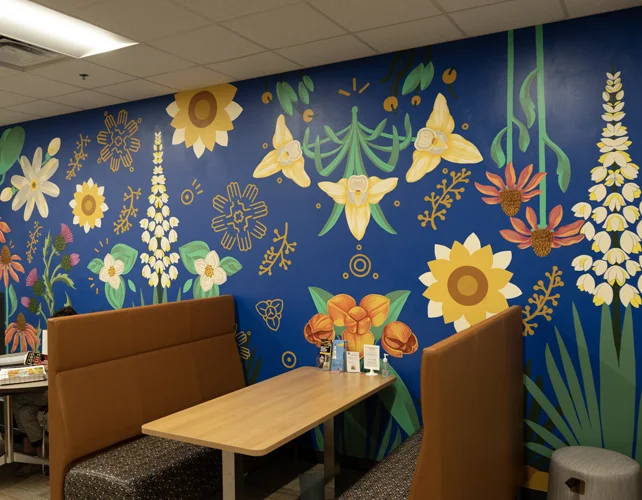
Evergreen collaboration area mural, 2022
Location: Evergreen Community Center & Library
Artist: Armando Minjarez
A dark blue wall that displays colorful floral foliage.
Evergreen collaboration area mural images
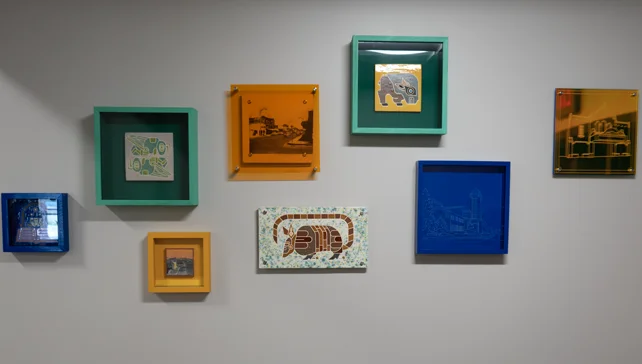
Evergreen collected art, 2022
Location: Evergreen Community Center and Library
Artists: Armando Minjarez and Carlos Palomino
This wall, just outside of the Arteaga community room, features images and designs of significance to the North End community. Images include line drawings of Wichita North High School and NoMar Theater. Designs include color versions of Carlos Palomino's animals used on acrylic dividers and glass elsewhere in the building.
Evergreen collected art images
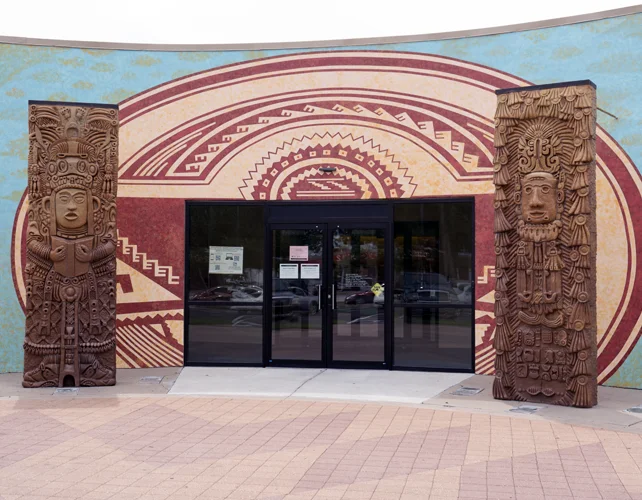
Evergreen entrance, 2003
Location: Evergreen Community Center & Library
Artists: Albert Martinez, Raymond Olais, and Conrad Snider
Approaching the building, there is a small plaza area with an early American quilt design created in paving bricks. Across from the small plaza in front of the entrance is a semi-circular façade wall with a doorway through the center. On either side of the doorway are two standing stone sculptures indicative of Mayan culture. The semi-circular wall is painted a bright golden yellow with an intricate brick red Aztec design painted on it.
The project designer was Raymond Olais, Albert Martinez was the muralist, and the two steles were created by Conrad Snider. The mural was repainted in 2016 by art maintenance contractor Jason Lonergan.
Evergreen entrance images
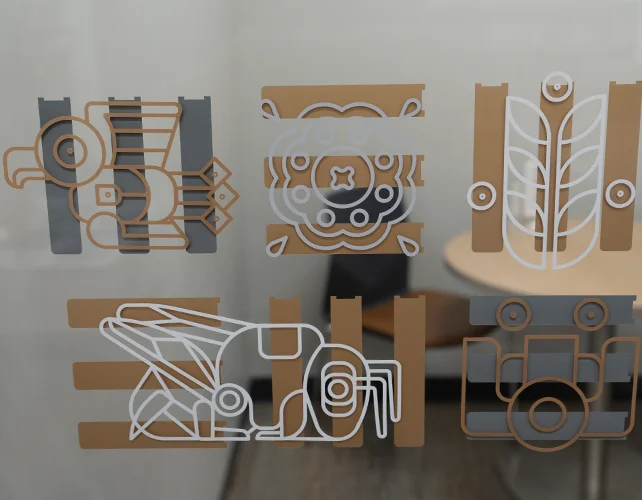
Evergreen interior glass, 2022
Location: Evergreen Community Center and Library
Artist: Carlos Palomino
This art symbolizes growth and self-sufficiency, displaying cultural symbology with graphics of ecosystems including animals, flowers, and insects. It incorporates simple cultural designs to the already clean and modern interior design. Book stacks are simplified to look like patterns found in Hispanic, Asian, Native American, and African cultures.
Evergreen interior glass images
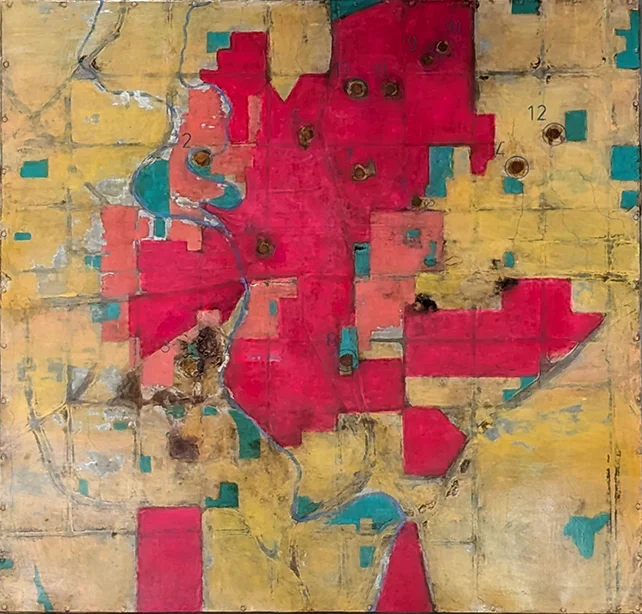
Geo Logic: Will Not Be Unseen/Finding the Holes in the System, Wichita, Ks., 2024
Location: Advanced Learning Library
Artist: Robert Bubp
48" x 48", acrylic, tar, acid etch, rust, pencil on steel
Created as a response to the art in the remodeled Chester I. Lewis Reflection Park, this work refers to multiple maps articulating the ongoing legacy of housing discrimination in Wichita and specific locations related to the actions Chester I. Lewis took against discriminatory laws and policies in the city in the 1950s-1970s. The artist describes the work in greater detail on his website.
Geo Logic: Will Not Be Unseen/Finding the Holes in the System, Wichita, Ks. images
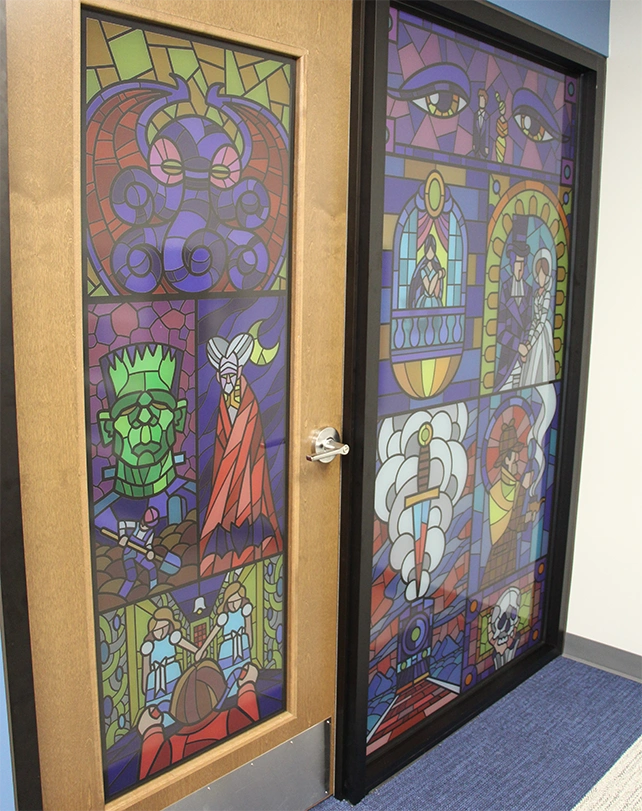
Illuminated Tales, 2025
Location: Rockwell Branch Library
Artist: Joe Worley
Created by Joe Worley, a member of the Brickmob art collective, with input from Wichita teens. These vinyl panels have a stained glass-inspired look and feature scenes from 20 distinct tales of literature. Printed and installed by Xpress Signs and Graphics.
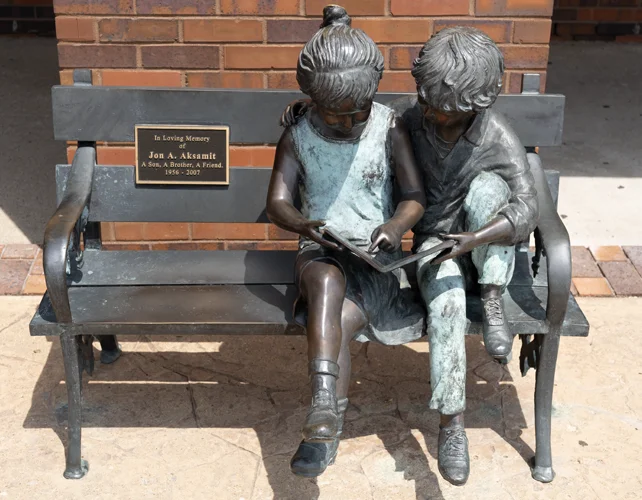
Jon Aksamit memorial bench, circa 2007
Location: Rockwell Branch Library
Artist: Max Turner
Bronze sculpture
This sculpture was donated by the family of former Wichitan Jon Aksamit then installed at the Rockwell Branch Library in June 2008. The plaque reads: "In Loving Memory of Jon A. Aksamit / A Son, A Brother, A Friend. / 1956-2007"
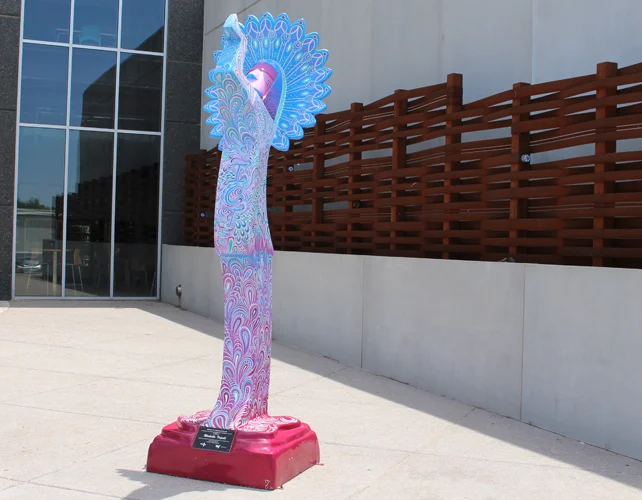
Keeper of a Brighter Future, 2020
Location: Advanced Learning Library
Artist: Michella Tripoli
One of thirteen 10-foot tall fiberglass "mini" versions of the Keeper of the Plains commissioned in recognition of Wichita's 150th year. These are part of a larger group collectively called the
Keepers on Parade. KPTS Channel 8 produced
a documentary about this and the other twelve Keepers from the "Keeper 150" project. A
map of all of the Keepers on Parade is available online.
Keeper of a Brighter Future images
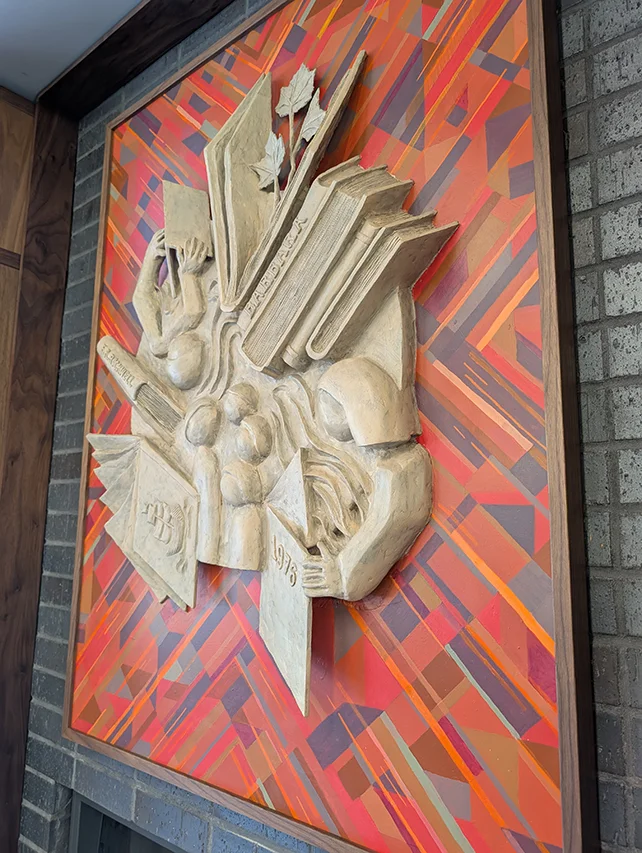
Knowledge Spinning Outward: a Tribute to the Rockwell Branch, 2025
Location: Rockwell Branch Library
Artist: Lindsey Kernodle
From the artist: "It is a bas relief sculpture atop a painted background. Elements refracting outward, almost like an explosion out of that central shape. This imagery is symbolic of the power of libraries and books and how their effects refract outside of the building, but spinning out into the community."
The artwork contains elements evocative of the Rockwell Branch and its namesake, Ford Rockwell, who was Wichita's head librarian from 1948-76.
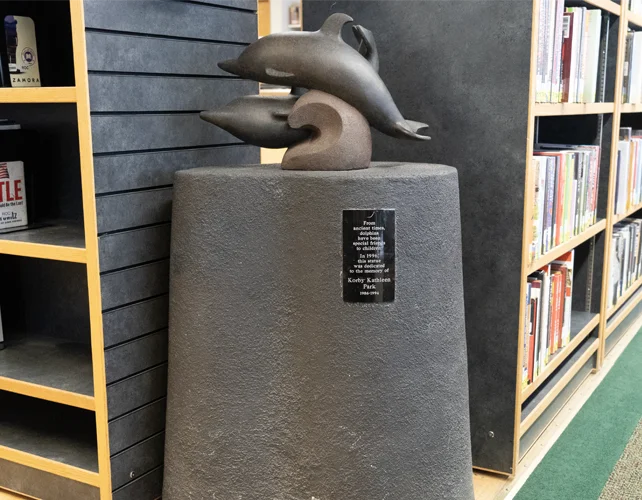
Korby Kathleen Park dolphin statue, 1996
Location: Rockwell Branch Library
Artist: John Seymour (1920-2007)
John H. Seymour was a ceramic sculptor who owned and operated a studio in Connecticut. He exhibited sculptures of animals nationally. This original piece shows two dolphins at play.
The plaque on the sculpture's base reads: "From ancient times, dolphins have been special friends to children. In 1996, this statue was dedicated to the memory of Korby Kathleen Park, 1986-1994."
Korby Kathleen Park dolphin statue images
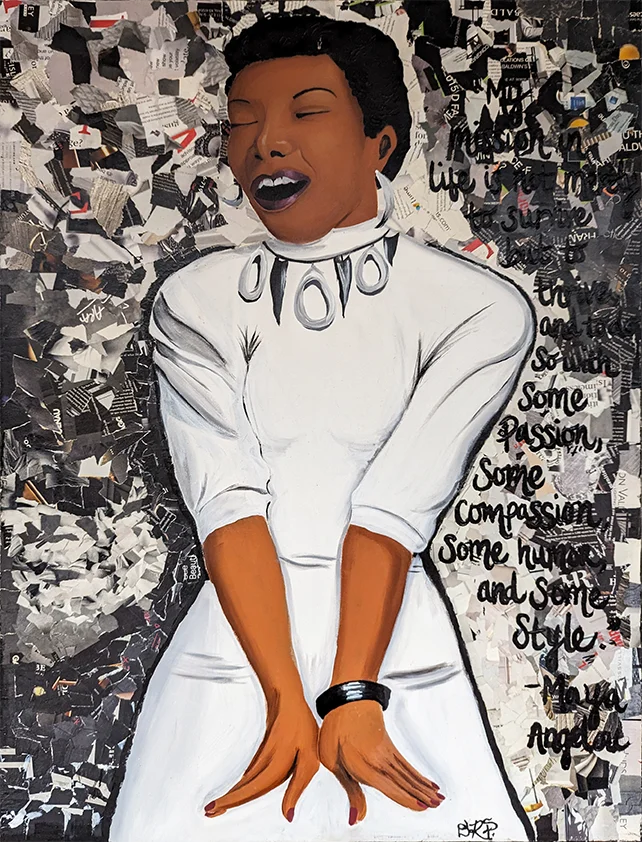
Maya Angelou, circa 2019
Location: Angelou Northeast Branch Library
Artists: Paris Cunningham, Dominique Joiner, and Rachael Harris
24" x 36", mixed media.
This work includes the Maya Angelou quotation, "My mission in life is not merely to survive, but to thrive; and to do so with some passion, some compassion, some humor, and some style."
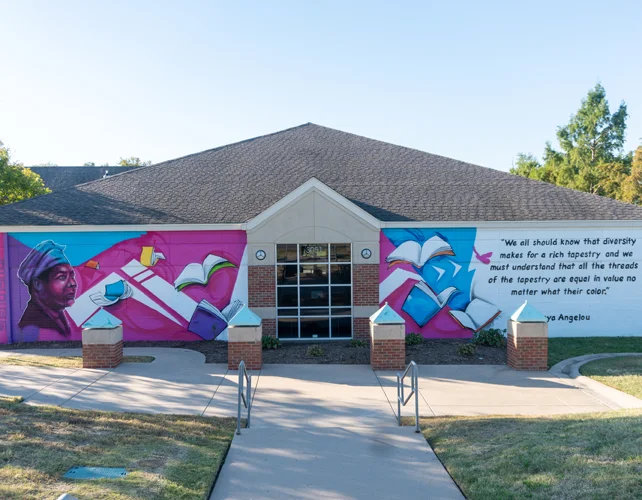
Maya Angelou mural, 2021
Location: Angelou Northeast Branch Library
Artist: Priscella Brown
In 2020, Kyle Ellison, Executive Director of Real Men, Real Heroes, proposed the installation of a mural on the north façade of the Maya Angelou Northeast Branch. Paying homage to Maya Angelou, the mural includes Angelou's likeness and words, used with permission from her estate.
The mission of Real Men, Real Heroes is to empower youth to build strong communities, and in support of that mission, area youth assisted with the project. "I believe [Maya Angelou] was a piece of art, and her work was art. So, we wanted to tie them all together and represent her. She was a light, a light to other people, and the Black community," said project coordinator Tiayla Maholmes, as quoted in The Community Voice.
Maya Angelou mural images

Maya Angelou Library sign, 2025
Location: Angelou Northeaast Branch Library
Artists: Ellamonqiue Baccus and Priscella Brown
This tribute to Maya Angelou features motifs from a group of nine historically African American fraternities and sororities formally called the National Pan-Hellenic Council, also known as the Divine Nine. The Divine Nine are Alpha Phi Alpha, Alpha Kappa Alpha, Kappa Alpha Psi, Omega Psi Phi, Delta Sigma Theta, Phi Beta Sigma, Zeta Phi Beta, Sigma Gamma Rho, and Iota Phi Theta. Maya Angelou herself was an inducted into the Alpha Kappa Alpha sorority as an honorary member in 1983.
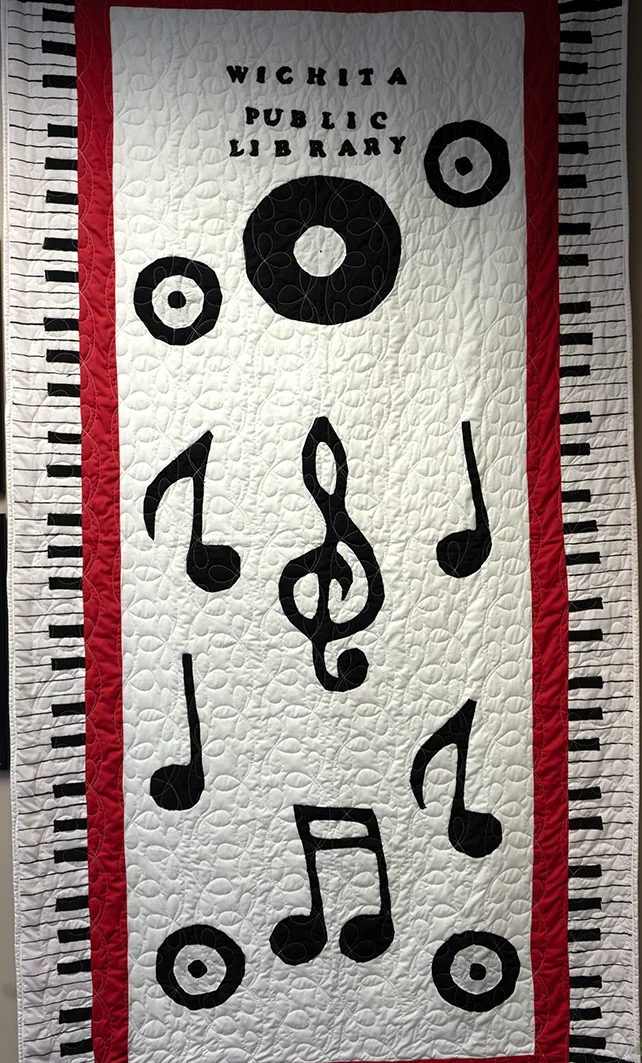
Music quilt, 2003
Location: Angelou Northeast Branch Library
Artist: Shirley Harrison (1936-2012)
Shirley Harrison was active in Wichita politics, serving as a precinct committeewoman. She was a member of the first Wichita River Festival committee and helped start the Black Arts Festival. She worked with many community organizations, including the Urban League and the American Legion. She participated in numerous sit-ins and marches, including the August 27, 1983 March on Washington. Shirley learned to sew and quilt from her grandmother. Shirley's two favorite quilts were called "How Hard They Worked" and "Celebration."
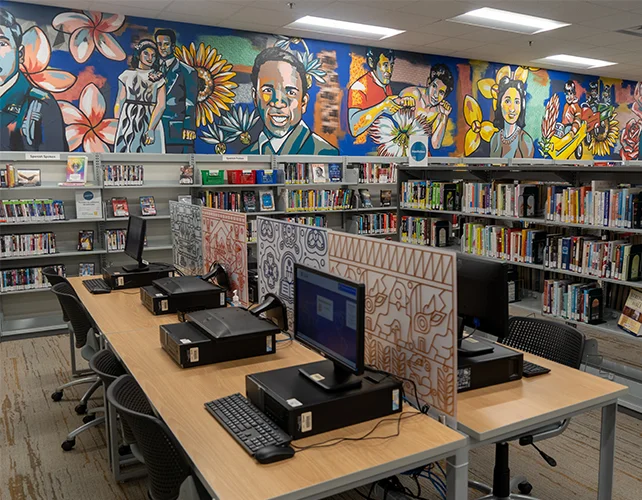
Neighborhood History, 2022
Location: Evergreen Community Center & Library
Artist: Heather Byers
"100 feet in length, spanning two walls, March 2022. This project is a love letter to an historic neighborhood in Wichita. It layers fabric and paint as well as a collage style to show all of the pieces that can be sewn together to create community. Individuals pictured are people who lived and worked in Wichita's North End. The floral designs mix the national flowers of many in the immigrant population with the Kansas Sunflower." (from the artist's website, no longer available)
Neighborhood History images
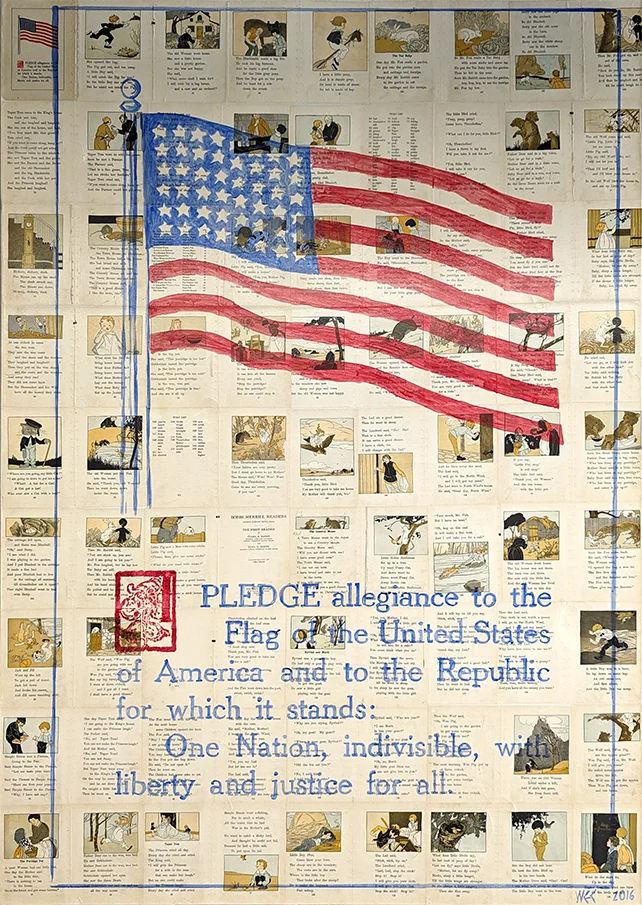
Pledge No. 2, 2016
Location: Advanced Learning Library
Artist: William Counter
An American flag with the Pledge of Allegiance printed over pages from The First Reader by Clara B. Baker, a book of illustrated fairytales and nursery rhymes originally printed in the U.S. in the 1920s that continued to be printed through at least 1936. The page in the upper left corner of the painting, featuring the flag and Pledge of Allegiance, apparently was the very first page in the book.
In 2018, William Counter had an exhibition at CityArts called "Red Stripe." The show featured "mass media objects like magazines, LP covers, and paperback books as inspiration for his paintings," as described by Curt Clonts for KMUW.
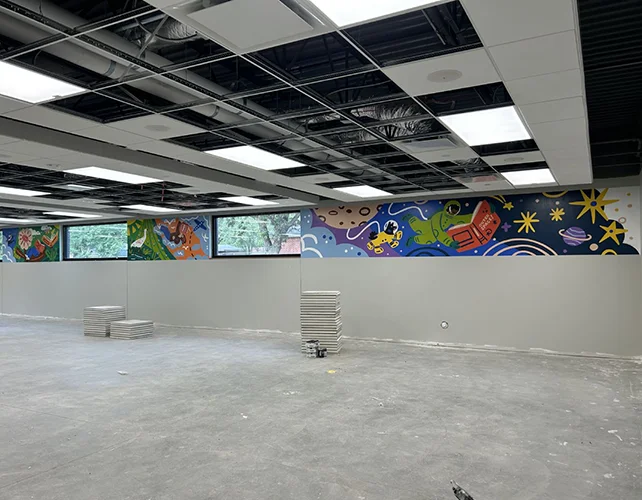
Rockwell children's room mural, 2025
Location: Rockwell Branch Library
Artist: Katie Lukes
The theme of this mural is exploration and immersion in a book. The mural features three connected scenes, each with a related book. The first panel contains a book about bees with garden landscapes, flowers, and bugs. It transitions into a wetlands scene with a whooping crane and then a person resting on clouds while reading about clouds. The final scene, set in outer space, has a child floating in a spacesuit reading about space.
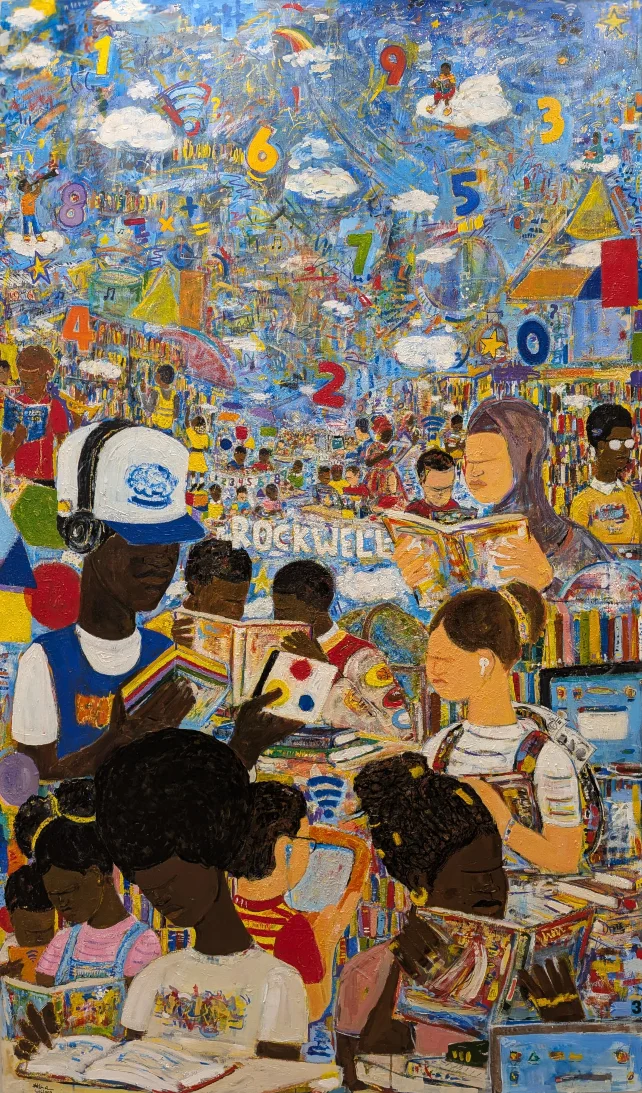
Rockwell hallway art, 2025
Location: Rockwell Branch Library
Artist: Sheldon Draper
The primary themes of this work are education, diversity, and intellectual growth. It includes numbers, letters, symbols, and shapes to reinforce the theme of academic exploration. The people in the work are learning through different methods; some by reading books and others through audio and visual technologies.
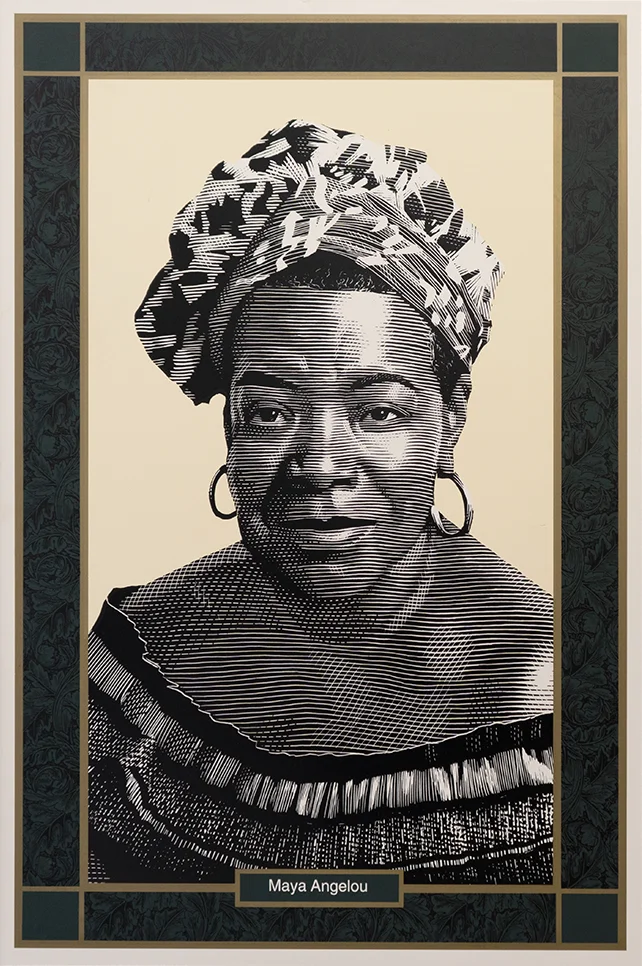
Scratchboard illustration of Maya Angelou, date unknown
Location: Angelou Northeast Branch Library
Artist: Mark Summers
Canadian artist Mark Summers began his full-time freelance illustrator career in 1978. His works emphasize the scratchboard technique, which involves using sharp tools to etch into a thin layer of white China clay that is coated with black India ink. Summers began working with Barnes & Noble in 1989, creating portraits of famous authors that would be used on tote bags and framed inside stores. His work has appeared in various publications, including Rolling Stone, Newsweek, The Atlantic, The New Yorker, Sports Illustrated, and Time. This picture has been at the library since at least 2010.
Mark Summers scratchboard demonstration video
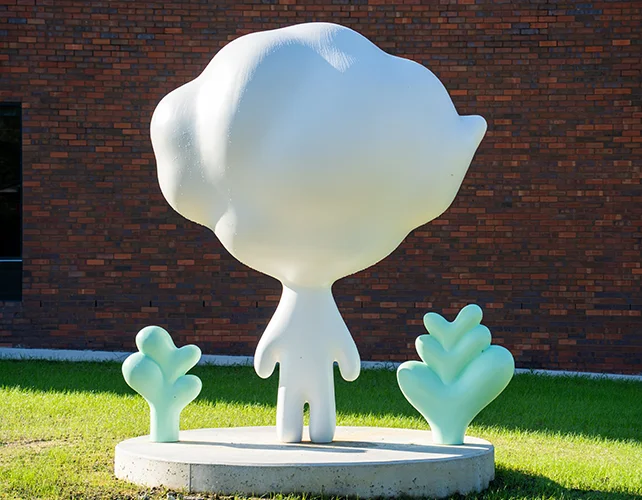
Silver Lining in Spring, 2025
Location: Rockwell Branch Library
Artist: Sujin Lim
This is one of a series of works by this artist exploring the concept of a "silver lining" through cloud forms. This sculpture has been inspired by the concept of the library as "a place we dream, think, long, and grow through our experience. The plants within the design represent a metaphor for growth. The figure represents the dreams we have. The sculpture is meant to create a welcoming atmosphere and pleasant uplifting space, particularly inviting for children." (quoted from Wichita Design Council meeting minutes)
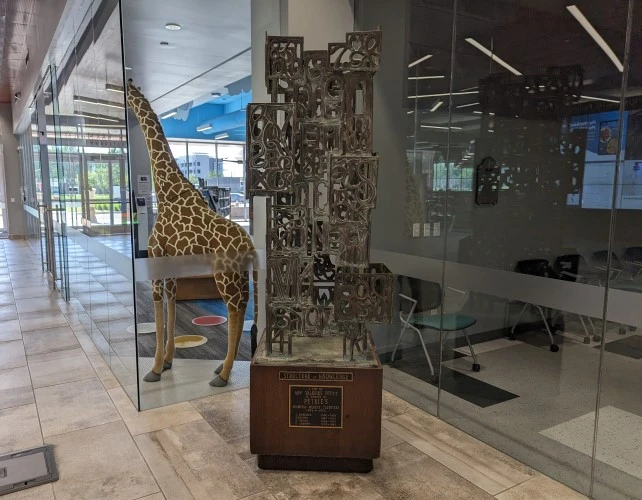
Structure of Knowledge, 1978
Location: Advanced Learning Library
Artist: Jack Zavatsky
In 1884, John Edward Petrie married Adeline Bruce and moved to Wichita, where he founded the Petrie's clothing store. His sons, Charles Judson and Richard Bruce Petrie, owned the business by 1923. In a Wichita Eagle report about the store's closing, it was written that a young J. E. Petrie "survived Quantrill's raid" on Lawrence in 1863. R. B. Petrie's first wife, Marguerite Smith, died in 1957. According to his obituary in the Wichita Eagle-Beacon, at the time of his death he was married to Annabelle Valerius Petrie (d. 1990), whose name features prominently on the artwork's plaque.
This artwork was unveiled at a reception at the Central Library on September 11, 1978. The sculpture had been displayed in the foyer of that building until it was moved to the Advanced Learning Library in 2018.
Structure of Knowledge images
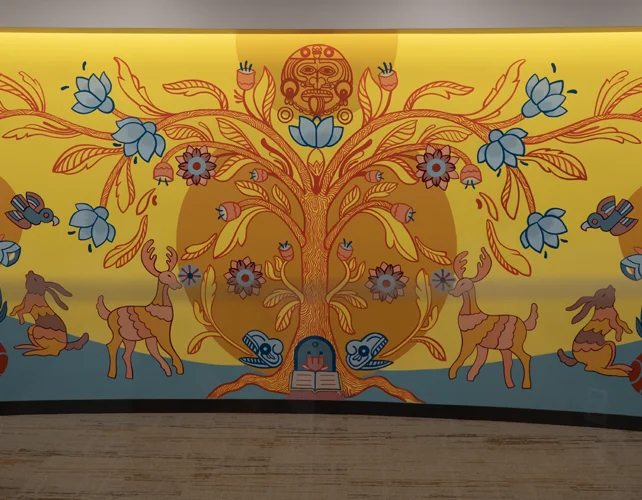
Tree of Life, 2022
Location: Evergreen Community Center & Library
Artist: Armando Minjarez
Árbol de la vida, or a Tree of Life, is a traditional Mexican pottery sculpture that displays narratives with patterns, elements, color, and nature. The curvature and uniqueness of the front wall by the reception at the center provides a visual effect that welcomes visitors to the center.
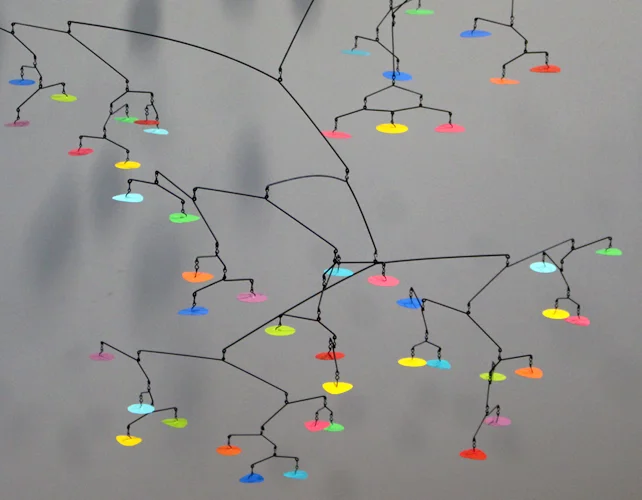
True Colors, 2023
Location: Advanced Learning Library
Artist: John Waltner
Steel rod, sheet metal, solder, acrylic paint with hardening protective coat, 12 x 6 x 6 ft. The mobile sculpture is comprised of approximately 130 pieces of painted shapes suspended on steel rods.
"To Waltner, this explosion of color (and its fitting name), pays homage to a public library's unconditional acceptance of its patrons. No matter who we are, where we've been, or what we are aiming to achieve when entering a library, we are accepted and welcomed. We are invited to seek the knowledge offered freely from a library’s shelves, unburdened by society's expectant gaze. The inspiration for this mobile came to John as he watched one of the Bethel Choir's winter concerts. There, a line from one of the songs struck him: 'Your true colors are beautiful.'" (from the artist's website)
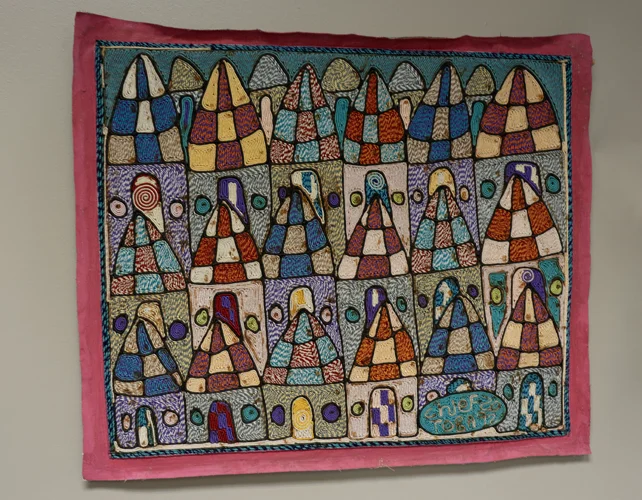
Village in Harmony, 1992
Location: Angelou Northeast Branch Library
Artist: Zacheus Olowonubi Oloruntoba (1919-2014)
Given to the City of Wichita as a gift from Chief Otunba Zacheus Olowonubi Oloruntoba of Ibadan, Oyo state, Nigeria when he visited Wichita for his showing at the Wichita Center for the Arts, February 2-March 21, 1999, Dorothy Rogers, curator. Fiber cord drawing on canvas. Hand-spun and vegetable-dyed fiber, applied with wheat paste. 20.5" x 24"
Village in Harmony images
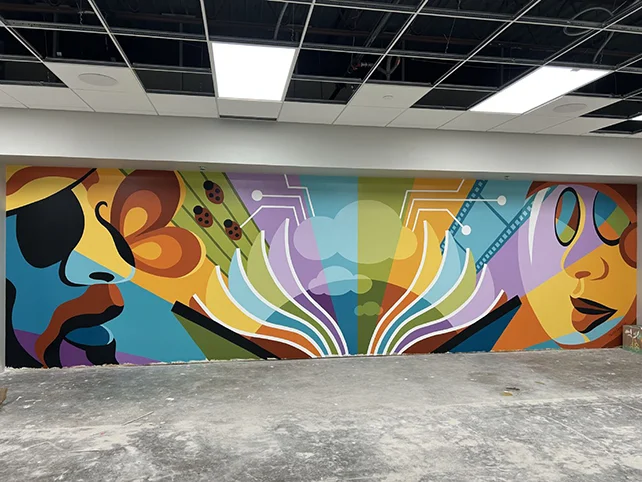
We Meet People in Books, 2025
Location: Rockwell Branch Library
Artist: Kelly Tompkins
According to the artist, this mural "features an open book, symbolizing discovery and learning, with pages that can almost take flight. This branch library is named after Ford Rockwell, a lover of pirates and the idea that we 'meet people in books,' said that 'we build for the future,' which is reflected in the astronaut, embodying a future-generation mindset."
She continues: "Mr. Rockwell's desire for people to discover the arts through the library lives on by hosting the Academy Awards Shorts program, represented by a filmstrip, and by welcoming the Wichita Symphony, pictured as ladybugs playing notes on a music staff. Connectivity is shown with the digital cloud and the butterfly pays tribute to the former children's librarian, Barbara Rockwell."
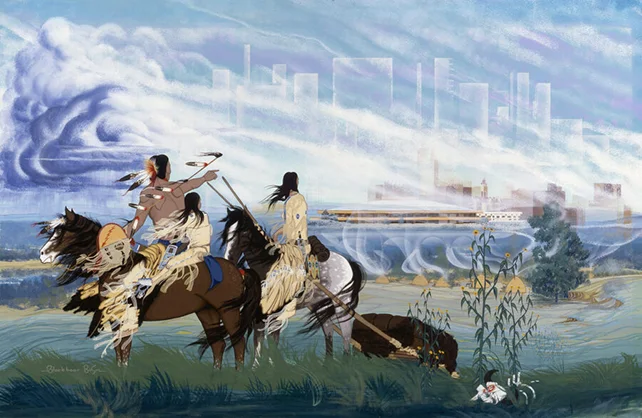
Wichita, My Son, 1965
Location: Advanced Learning Library
Artist: Blackbear Bosin (1921-1980)
Print 894/1500. Original held at the Wichita Art Museum: gouache on illustration board, 40 3/4 x 62 inches.
Bosin's stepson, David Simmonds, wrote in Blackbear Bosin: Keeper of the Indian Spirit, "In February 1965 the Wichita Art Museum hosted its first Blackbear Bosin show, which included 24 paintings. Blackbear was commissioned by Henry A. Humphrey to do a painting showing the relationship of the Indian people and Wichita. Blackbear completed Wichita, My Son for Humphrey, who then donated the piece to the Wichita Art Museum."
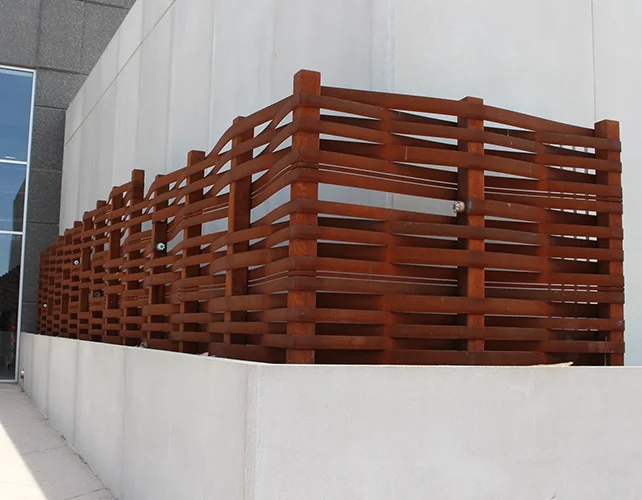
Woven, 2018
Location: Advanced Learning Library
Artists: Kent Thomas Williams and Stephen Atwood
"Woven" mixes horizontal strands and colorful lights to represent pathways of learning that form a unified whole.
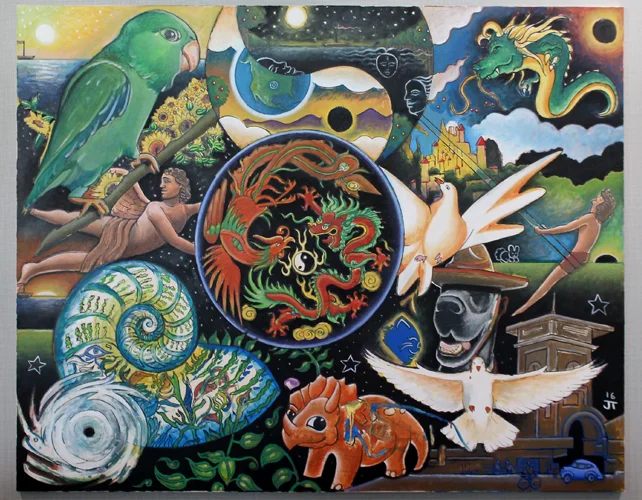
Zero Balance, 2016
Location: Advanced Learning Library
Artist: Josh Tripoli
Zero Balance was created in July 1, 2016 during an ARTLESS: A Community Art Experience held at CityArts. This piece was purchased by the Arts Council with Knight Foundation funds and gifted to the Advanced Learning Library on August 10, 2018.
Zero Balance video
